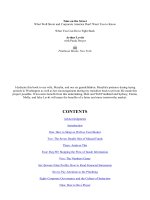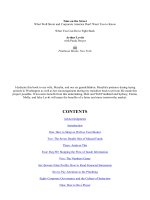Tài liệu How the Drive for Quarterly Earnings Corrupted Wall Street and Corporate America doc
Bạn đang xem bản rút gọn của tài liệu. Xem và tải ngay bản đầy đủ của tài liệu tại đây (1.66 MB, 915 trang )
THE NUMBER
How the Drive for Quarterly Earnings
Corrupted Wall Street and Corporate
America
ALEX BERENSON
RANDOM HOUSE
NEW YORK
FOR MY BROTHER DAVID,
A TRUE FRIEND
It is difficult to get a man to understand
something
when his salary depends on his not
understanding it.
UPTON SINCLAIR
Prologue
One of Many
January 22, 2001, 5:30 P.M. Darkness has
settled over the East Coast, but the mood
is sunny in the executive suites at the
Islandia, New York, headquarters of
Computer Associates. The world’s fourth-
largest independent software company has
just released its quarterly earnings for the
three months ending December 2000, and
the report is a good one. Sales and profits
are higher than Wall Street anticipated.
No one will benefit from the news more
than Charles Wang, the chairman of
Computer Associates, and Sanjay Kumar,
the company’s chief executive, good
friends who have just bought the New
York Islanders professional hockey team.
Wang owns 30 million shares, more than
$1 billion, of the company’s stock. Kumar,
a relative pauper, has about $200 million
in Computer Associates shares. Those
fortunes will grow the next day, as
investors bid Computer Associates’ stock
up almost 6 percent.
After issuing the report, Computer
Associates holds a conference call to
discuss its results with the Wall Street
analysts who follow the company. Kumar
can’t resist bragging. Although the
software industry is in its worst downturn
in a decade, his company has
demonstrated its strength. “We’re
extremely pleased with the performance
we pulled off,” he says.1
If she had been on the call, that news
would have come as a surprise to Mary
Welch. Welch, a Computer Associates
sales rep, had been fired by the company a
week earlier, one of three hundred
employees laid off as 2001 began. Like
most of the fired employees, Welch was
told she would not receive any severance
pay, because she had been dismissed for
poor performance. Yet she had received a
positive job review only two weeks
before. Welch and many other fired
employees believed that Computer
Associates wanted to avoid paying
severance by disguising a company-wide
cutback as individual firings. The layoffs
were necessary because the company’s
sales had plunged in the December
quarter, the fired employees claimed.
“They did a mass layoff,’’ Welch said.
At the time, Welch’s complaints seemed
nothing more than the gripes of a
disgruntled ex-employee. After all,
Computer Associates’ financial statements
showed that business had been better than
ever in the December quarter, with sales
up 13 percent and profit up almost one-
third. Surely the company couldn’t just
make up its results.
But Mary Welch was right. Thanks to an
audacious accounting trick, Computer
Associates had found a way to rewrite its
financial statements. The company had
divorced the reality of its business, a
business in decline, from the profit-and-
loss picture it presented to Wall Street.
Breaking the most basic conventions of
accounting, it was rebooking sales and
earnings that it had already reported.
Computer Associates was not a penny
stock operating in the shadows of the
market. It had eighteen thousand
employees, tens of thousands of
shareholders, and a market value of more
than $20 billion, more than Nike or
Federal Express. Yet no one— not the
analysts paid to decipher the truth of
Computer Associates’ fortunes, not the
accountants legally required to certify its
books, not the mutual fund managers who
bought its stock, and most certainly not the
regulators who oversaw the U.S.
securities markets— had blown the
whistle on the company’s accounting
maneuvers.
There are fourteen thousand publicly
traded companies in the United States.
Expecting all of them to be honest is
unrealistic. Like any town of fourteen
thousand, the market is bound to have its
share of grifters and shoplifters. But the
deception at Computer Associates was
dangerous precisely because it wasn’t an
aberration. By January 2001, all manner
of companies were abusing accounting
rules to mislead their investors, seemingly
without fear of being caught. A strange
madness had gripped the market. Even its
most solid citizens were running red lights
and breaking windows. And the police
were nowhere in sight.
Introduction
System Failure
On Wall Street, not all numbers are
created equal.
New home starts. The consumer
confidence index. Retail sales. Overnight
television ratings. Unemployment claims.
PC shipments. Casino winnings in Atlantic
City and the Las Vegas Strip.
The figures roll out every day from
government agencies and industry trade
groups and independent analysts.
Watching them all is impossible; most
speed by unnoticed.
But one set of numbers burns brighter than
the rest. Every three months, publicly
traded United States companies report
their sales and profits to their
shareholders. Those quarterly
announcements are the lodestar that
investors— and these days, that’s most of
us— use to judge the health of corporate
America.
It makes intuitive sense that corporations
must regularly tell their shareholders how
much money they have made or lost.
What’s your weekly paycheck? Did you
get a bonus last year? All in all, how much
money did you make? You know the
answer, without much trouble. Why
shouldn’t Exxon and General Motors?
They should, and they do. Every quarter
they add up their sales and costs, and
figure out where they stand. Then they tell
the world, in press releases and
conference calls and most important in
reports that they file four times a year with
the Securities and Exchange Commission,
the federal agency that regulates U.S.
stock markets. To be precise: Three
quarterly reports, or 10-Qs, submitted to
the S.E.C. within forty-five days after a
quarter ends. One 10-K, the big one, the
audited annual report, to be filed less than
ninety days of the end of a company’s
fiscal year. Qs and Ks, in Wall Street
shorthand.
Qs and Ks are monuments to numbers.
Revenue. Selling, general, and
administrative expenses. Operating
income. Interest paid. Columns of huge
numbers, eight, nine, or ten figures long,
fall down the page in black and white to
land with a bang disguised as a whimper
at one small number: earnings per share.
Earnings per share is usually no more than
a couple of bucks, an unprepossessing sum
compared to the giant figures above. But
its small size is deceiving. Multiply a
dollar or two per share by hundreds of
millions of shares, and you have real
money. A stray penny on the 10 billion
shares that General Electric has
outstanding turns out to be $100 million.
Even within a profit report, not all
numbers are equal. For traders and
investors of all sizes, earnings per share is
the ultimate benchmark of a company’s
success or failure. Has it risen from the
previous quarter and the previous year?
Has it met the “consensus”— the average
estimate of the Wall Street analysts who
follow the company? More than any other
number, earnings per share determines
whether a company’s shares will rise or
fall, whether its chief executive will be
rewarded or fired, whether it will build a
new headquarters or endure a round of
layoffs.
On Wall Street, a place of little subtlety,
earnings per share is known simply as
“the number.” As in “What was the
number for Pfizer?” Earnings per share is
the number for which all the other
numbers are sacrificed. It is the distilled
truth of a company’s health. Earnings per
share is the number that counts.
Too bad it’s a lie.
Under the best of circumstances, the
figures in a quarterly report— earnings
per share most of all— are
approximations, best guesses based on a
thousand other best guesses. Earnings
reports are about accounting, and the
accounting that big companies use to
measure their financial health has as much
in common with the way you balance your
checkbook as a five-alarm fire has with a
backyard barbecue.
If you’re like most people, your paycheck
is your main source of income. Over the
last few years, if you work for a publicly
traded company, you may have gotten
some stock options too. Those are nice,
but the local grocery store prefers cash, so
if you’re wise, you won’t figure options as
income, either, until you cash them in.
Then there’s the other side of the ledger:
spending and saving. The distinction is
usually clear, although the line blurs at
your mortgage payment, since part of that
is going to build equity in your home.
Still, your personal accounting is
relatively straightforward. You can easily
compare how much you’ve earned and
how much you’ve spent, because you get
paid in cash and you spend cash (or use a
credit card, which you pay off within a
few weeks).
But big companies measure their costs and
revenues in a very different way. Instead
of simply counting the cash they are
making and spending, they use something
called “accrual accounting.” Under
accrual accounting, a company books
revenue when it makes a sale, not when it
actually receives the cash for the sale. It
books an expense when it agrees to buy
something, not when it actually pays.
Accrual accounting also recognizes that
companies invest in assets that will last
many years, and it allows the companies
to spread the cost of those assets over
their life. For example, an airline doesn’t
expense the entire price of a new plane up
front. Instead, it recognizes the cost of the
plane over many years, as the aircraft’s
value “depreciates.”
In theory, accrual accounting makes sense.
Cash accounting can make companies
appear to be losing money just when their
business is ramping up and they’re making
lots of sales for which they’ll be paid in
the future. *
But what makes sense in theory can be
abused in practice. Because they’re not
simply measuring cash inflows and
outflows, companies need to make
hundreds of assumptions to calculate their
earnings each quarter. They must estimate
everything from how much money they
will earn on their pension funds to how
quickly their assets will lose value. †
With so many assumptions to make, even
honest companies sometimes make
mistakes. Those that want to cheat have an
almost infinite number of ways to do so.
They can book sales to customers who
won’t ever be able to pay them. They can
hide ongoing, day-to-day expenses as
investments in long-lived assets. They can
shift research and development expenses
to supposedly independent partners. They
can make sham deals with other
companies, swapping overvalued assets in
a way that allows both sides to book a
profit on the trade.
Used properly, accrual accounting is
about timing, not about creating profits
where none exists. Over the long run, the
profits that a company reports under
accrual accounting should jibe with the
cash it receives and spends. Over the long
run, companies that make sales to
customers who can’t pay will have to
admit that their clients are deadbeats.
Over the long run, a company can’t hide
operating expenses as capital spending,
because it will wind up with a balance
sheet full of nonexistent assets. Over the
long run, all the accounting and financial
tricks in the world can’t turn a failing
business into a success.
But they can in the short run. And
sometimes, with enough tricks, the short
run can last a long time, long enough for
executives to make tens or even hundreds
of millions of dollars selling stock whose
value has been inflated by pumped-up
earnings.
Given the importance of the number, and
the ease with which it can be manipulated,
you might expect that investors would
look at earnings per share with a skeptical
eye. You might think they would carefully
read the footnotes buried at the bottoms of
Qs and Ks, and examine a company’s cash
flows to see whether its profits have any
basis in reality.
But you’d be wrong. As a rule, before
2002, most individual and professional
investors didn’t worry much about
accounting. As long as a major accounting
firm certified that a company’s financial
statements were prepared according to
GAAP, or “generally accepted accounting
principles,” shareholders took them at
face value. Investors held as an article of
faith that the quality of corporate financial
reporting in the United States was better
than anywhere else. Watched over by the
Securities and Exchange Commission and
independent accountants, American
companies had no choice but to tell Wall
Street the truth. U.S. markets were the
fairest and most honest in the world.
Like most deeply held beliefs, this
shibboleth overlooked inconvenient
realities. The S.E.C. had never been given
a budget large enough to check every
financial statement for irregularities.
Accountants had always had to balance
their responsibilities to investors with
their paychecks, which came from the
companies whose books they audited.
Still, if history was any guide, investors
had reason to be confident. The
combination of mandatory corporate
disclosure and federal oversight seemed
to have worked since its creation in 1934.
Sure, the concept behind the number—
that public companies could precisely
calculate their earnings each quarter—
was a lie. But as long as companies
prepared their financial statements in good
faith, it was a white lie. Companies might
not always be able to calculate their
profits exactly, but if they made honest
estimates they ought to be close. And for
two generations they had been close.







